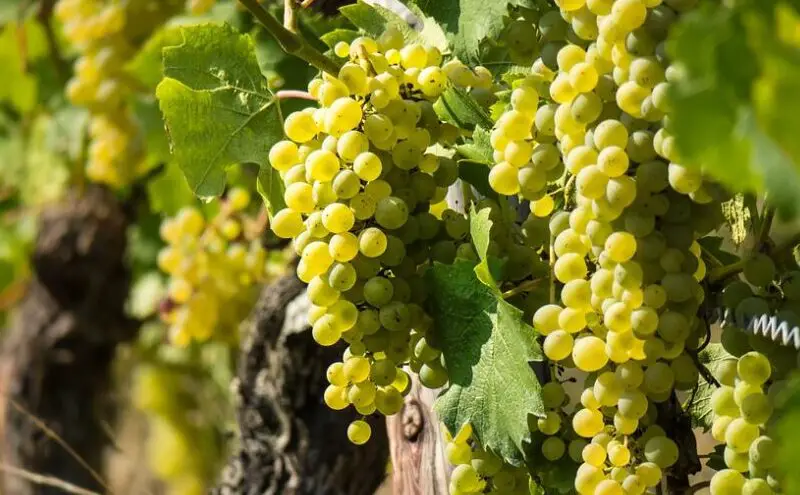In addition to producing bunches of grapes to enjoy in early fall, the grape plant (vine) is a beautiful plant that can cover a sunny wall or run across the top of an arbor.
Hardy, the grapevine is adapted to all types of soil and is very resistant to drought. This climbing shrub can grow up to 15 ft tall with a rapid growth of 18 to 25 inches per year. Not demanding in terms of soil quality, the vine requires only a rigorous pruning, and leaves you with a wide choice of trellises.
Contents
Which grapes to plant in your backyard ?
Vines belong to the genus Vitis. The best known species cultivated for its grapes is Vitis vinifera. Others, like the Coignet vine, are only decorative. The wine and table grapes are cultivars from Vitis vinifera.
The shape and color of the leaves, the shape of the bunches, the color of the grapes, but especially its flavor, its earliness (in cold regions, avoid late varieties) and its resistance to diseases (mildew, black rot) depend on the variety.
The vines you will find to buy are generally grafted on American species and varieties, resistant to phylloxera. Each of these varieties has its own ability to develop in a particular environment: soil of varying depths, limestone, resistance to drought… A good knowledge of the soil is, therefore, necessary to choose the rootstock.
When to plant your vines ?
Plant in winter (resting period), while avoiding periods of frost.
In a hole, bring 4 handfuls of fruit fertilizer and 2kg of composted manure, then cover with loose soil, making sure that the roots are not in direct contact with the manure.
Where to plant your grapes in your backyard ?
Not very greedy, the vine (grape) likes a dry, even stony soil, which keeps the heat in summer. Grapes hate stagnant water at their feet. This is why it is often planted on a slope to allow water to drain away quickly.
The ornamental vine can be grown in the shade without affecting the quality of its foliage.
How to plant grapes in your backyard (vine) ?
You will need to consider the future development of the grapevine’s branches by keeping a space of 8 to 9 ft between feet leaning against the same wall, and 3 ft for feet forming a row.
Prepare planting holes about 1 ft in diameter and depth. Water the bottom well and pour in some compost and cover it with a handful of soil to prevent the roots from coming into direct contact with the compost.
Before adding the handful of soil, you can put some organic fertilizer (dried blood, crushed horn…) or, as it was done in the past, a bit of sheep’s shearing or a piece of thick wool to absorb moisture.
If it is a bare-root vine plant, it will be beneficial to dress the roots (cut them back a few centimeters) and to pralinate them beforehand.
Once the plant is in place, the hole should be filled in with the soil initially extracted, making sure that the grafting point is between 1 and 2 inches above ground level, and forming a small bowl to facilitate subsequent watering. Immediate watering is of course necessary.
Install a stake of about 3 ft, as soon as planted.
To prevent rabbits, deer and other browsing mammals from wiping out your newly planted vine, install a wire mesh sleeve around it. Afterwards, especially when the buds burst, keep a close eye on them to prevent them from growing through the mesh, as it will be difficult to remove them without damaging them.
Pruning and maintenance of table vines (grapes)
The vine needs to be trained before giving its first fruits. In all cases, severely prune to 1 or 2 buds the year of planting in order to strengthen the vine.
During vegetation, train the obtained branches. You can then lead your grapes in short vine, or train it on a trellis or a pergola. In the second case, the secondary branches will be pruned according to the principle of trigemme pruning, although the Chasselas varieties prefer to be pruned with two eyes.
It is best to intervene in February and March, before the vegetation starts to grow again. Summer pruning operations are also necessary.
If well managed, grapes are little affected by diseases, only mildew and powdery mildew can sometimes dramatically attack the foliage and the young fruits. After pruning, a treatment at the end of winter, followed by a treatment with Bordeaux mixture as a preventive measure. During vegetation, apply fungicide or Bordeaux mixture treatments as soon as the first symptoms appear. In order to preserve the fertility and the acidity of the soil and to induce a good fructification, a contribution of organic manure can be made every year in autumn.
Which grape varieties should I choose?
In cold regions, prefer early maturing varieties, preferably grown in greenhouses.
- For easy to maintain, very productive and resistant to mildew, anthracnose, powdery mildew…, choose the red-fleshed ‘Ampelia Aladin’ vine or the white-fleshed ‘Ampelia Candin’ vine. In addition to being very pleasant to eat (crunchy and musky grains), these two varieties are self-fertile: the vine produces fruits without a male or female plant.
- For the same resistance and high productivity, choose the ‘Perdin’ variety, with white flesh and juicy and tasty berries. Particularly early.
- For an abundant fruiting, the variety ‘Chasselas doré’ produces golden grapes with juicy and sweet white flesh and thin skin in mid-September. It ripens very late and is ideal in warm regions.
- Similarly, the variety ‘Alphonse Lavallée’ produces large bunches of black grapes.
Planting grapes in a pot?
Did you know that? Grapes can be planted in pots! In this case, you need a container with at least 4 inches of soil under the roots and as much on top? This type of culture requires some special attention:
- The choice of a variety and a rootstock with low vigor;
- Regular fertilization and watering;
- The renewal, every year, of one third of the soil.








